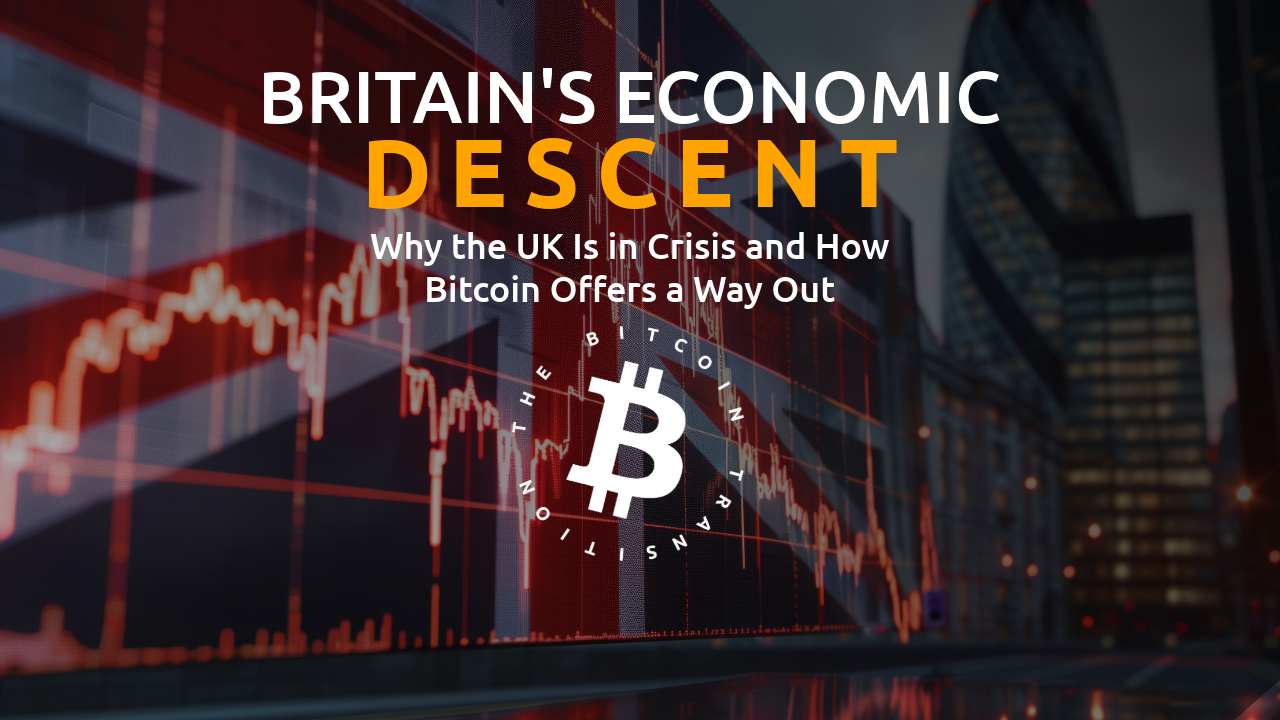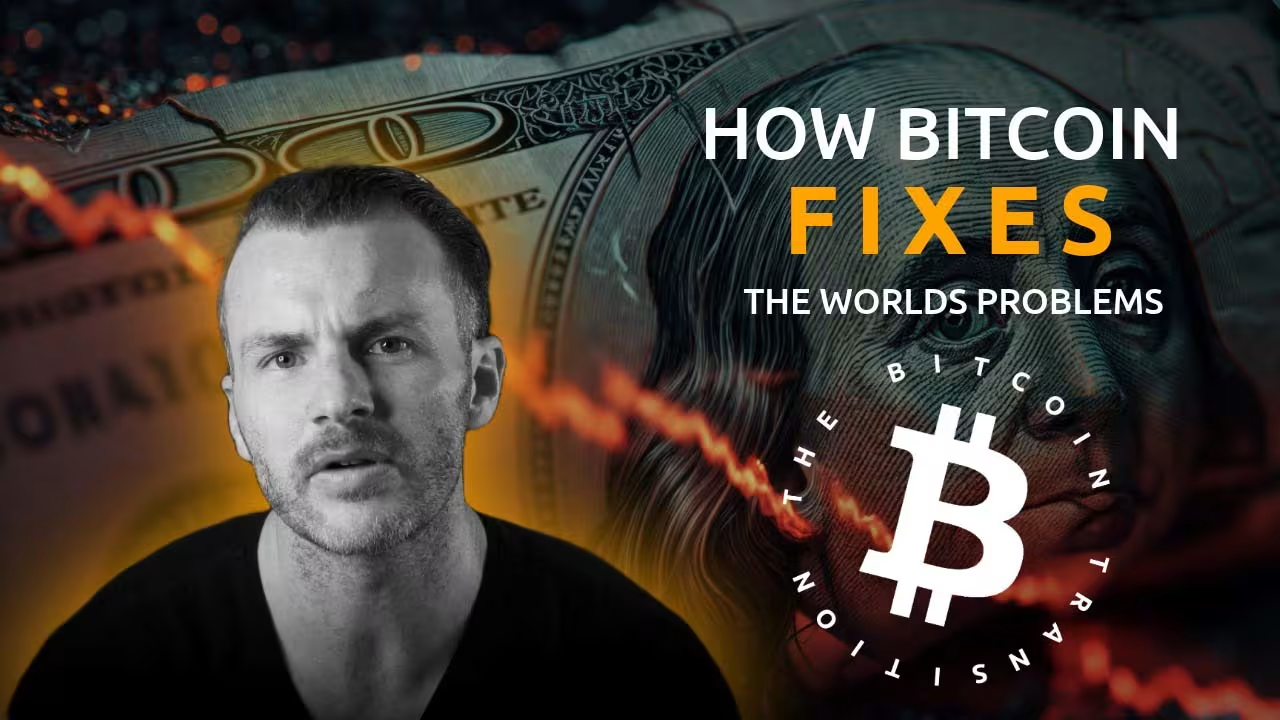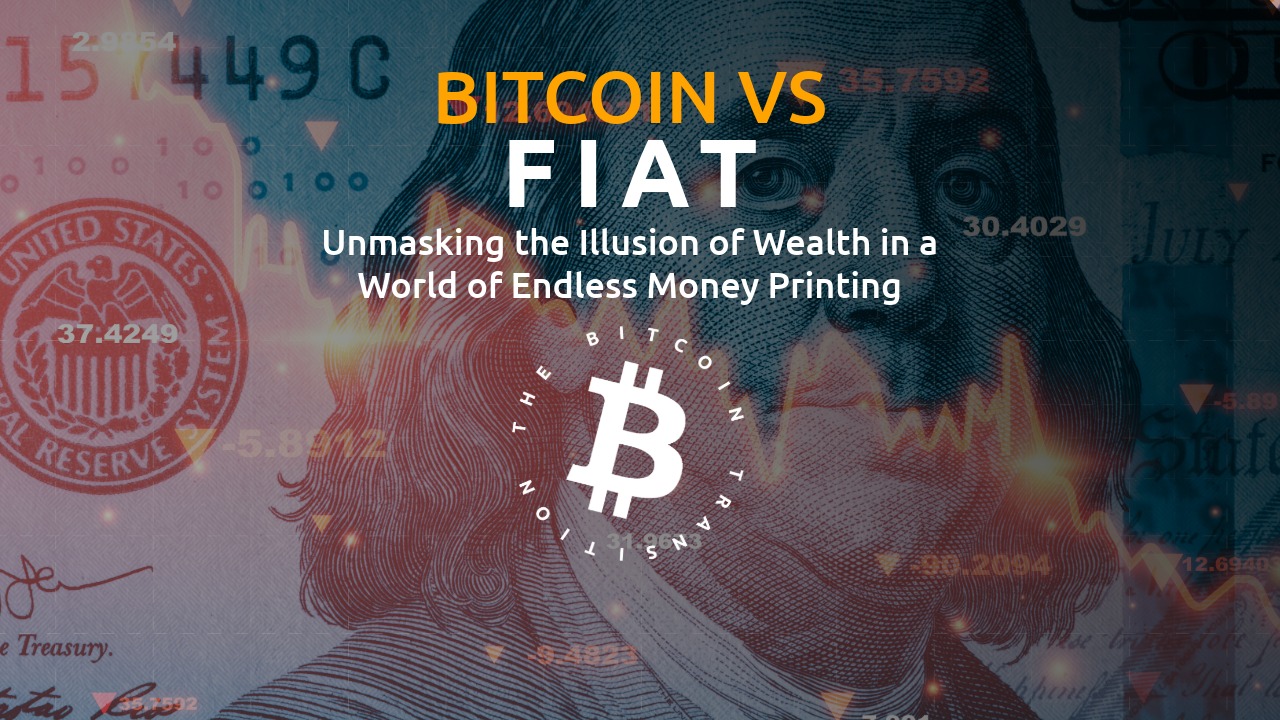Britain’s Economic Descent: Why the UK Is in Crisis—and How Bitcoin Offers a Way Out
UK economy in decline. Bitcoin is Britain’s last hope for financial sovereignty and stability.

The Long Slide from Hard Money to Fiat: Britain’s Turning Point
This shift removed the monetary anchor that had enforced discipline—allowing governments to expand the money supply at will. Without convertibility, inflation became a latent force, gradually eroding the purchasing power of the pound.
In abandoning the gold standard entirely—first domestically in 1931, and globally in 1971—Britain relinquished its monetary discipline. With it went the pound’s credibility, savers’ trust, and Britain’s position as a financial beacon. What remained was a currency vulnerable to inflation, depreciation, and manipulation—marking the beginning of a century-long erosion of real wealth and institutional restraint.
How Citizens Got Poorer: Real Wages, Housing, and the Illusion of Wealth
It’s deceptively easy to look at rising nominal wages and house prices and assume prosperity. But unless you measure value correctly—taking inflation and depreciation into account—the reality is far bleaker.
Stagnating Real Wages
The Institute for Fiscal Studies (IFS) supports this analysis, showing median earnings rose just 3.5% between 2009–10 and 2022–23—among the weakest performance in the OECD peer group.
High Inflation, Slow Wage Gains
Inflation surged in late 2022, with the CPI hitting 11.1% in October, the highest rate in over 40 years, as core essentials like energy and food prices soared. Though nominal pay began to outpace inflation by mid‑2023, with wages up around 5% and real growth at only ~1.1% by spring 2025, inflation remained elevated at about 3.6% in June 2025, eroding most recent wage gains.
Housing Illusion Busted by Gold Valuation
A Nation in Debt: Soaring Deficits, Public Liabilities, and Monetary Addiction
The UK government has run budget deficits virtually every year since World War II. However, the fiscal position deteriorated sharply during the COVID era and has remained precarious ever since.
Record‑breaking borrowing in 2020–21
Debt now at nearly 100% of GDP
By 2023/24, public sector net debt reached approximately £2.686 trillion, representing about 96% of GDP. Recent reports confirm that public debt stands at 96.3% of GDP as of mid‑2025—a high level not seen since the 1960s.
Pension liabilities dwarf official debt
Money printing made it worse
Taxation at record levels—yet no balance
Even now, with the tax‑to‑GDP ratio sitting at a post‑war high of around 37–38%, Britain is still unable to achieve a balanced budget. Borrowing continues, deficits persist, and overall public debt continues to climb.
Systemic fragility and monetary addiction
The fiscal model the UK relies upon is unsustainable and highly vulnerable. It requires:
- Keeping interest rates artificially suppressed.
- Monetising deficits through central bank asset purchases.
- Deferring the costs of public promises—especially pensions—to future taxpayers who are shrinking in number.
- Running persistent deficits even during recovery periods.
Watchdog bodies like the Office for Budget Responsibility (OBR) warn that unless corrective action is taken, public debt could rise to over 270% of GDP by 2070, fueled by pension costs, climate spending, and demographic pressures.
Experts also highlight a looming structural issue: as defined‑benefit pension schemes unwind, their gilt‑buying demand will shrink. This could raise government borrowing costs and increase annual interest bills by an extra £22 billion or more .
Labour’s Tax Strategy and the Exodus of Wealth and Talent
Political decisions in recent years—led by the Labour government—have signalled a markedly tougher fiscal regime for the wealthy. In April 2025, Labour abolished the centuries‑old “non‑dom” tax status, ending a tax loophole that allowed wealthy foreign residents to avoid paying UK tax on overseas income or gains. Alongside this, the government introduced higher employer National Insurance contributions, tightened inheritance tax rules, and floated proposals to apply VAT on private school fees—all signalling that capital would no longer enjoy preferential treatment in the UK.
The result has been dramatic. John Fredriksen, previously the UK’s ninth-richest resident, publicly declared that “Britain has gone to hell” and announced he was relocating to tax-free Dubai—listing his £250 million Chelsea mansion for sale and shutting down his London operations. Industry forecasts show the UK lost approximately 10,800 millionaires in 2024, and analysts project a further 16,500 departures in 2025—the largest exodus on record for any country , though some experts caution that the methodology underlying these estimates may be flawed.
This capital flight drains entrepreneurial energy, investment, and tax revenue—precisely at a moment when the UK needs more of all three to reverse its economic decline.
Demography and Desperation: An Unsustainable Population Strategy
Britain’s population is ageing rapidly, and birth rates remain low—shrinking the ratio of workers to pensioners and placing mounting pressure on public finances. Rather than structural reform, successive governments have relied on mass immigration to supplement the workforce and prop up tax revenues.
This “population patchwork” approach is, in reality, a demographic Ponzi scheme—one whose sustainability depends on continuous high inflows.
A Cost-of-Living Crisis Felt by All
This is not a cyclical blip—it’s a structural recalibration of the economy under the combined pressures of inflation, debt, shrinking real income, and fiscal mismanagement.
UK Economy Overview—At a Glance
Despite these indicators, the outlook is grim. Growth is weak, inflation eats wages, government debt is high, and the electorate faces rising taxes and stagnant services.
Why the System Is Broken and Bitcoin Is the Answer
Britain’s economic stagnation, rising inequality, and fiscal stress all trace back to one fundamental issue: the abandonment of hard money. Fiat currency—money issued without any asset backing—has enabled a century of political and financial mismanagement, allowing governments to borrow, print, and spend without constraint.
This is not conjecture—it’s well documented. The transition from the gold standard to fiat systems has accelerated inflation, weakened currencies, and undermined real wages, as covered extensively by economists such as Friedrich Hayek, and modern analysts like Saifedean Ammous in The Bitcoin Standard (mises.org, bitcoinstandard.com).
Here’s what fiat enables:
- Inflation silently robs savers, devaluing cash and wages.
- Asset bubbles widen inequality, as monetary expansion fuels speculation and real assets become out of reach for most.
- Public debt grows unchecked, since politicians face no hard constraint on borrowing.
- The tax base shrinks, as high earners and entrepreneurs flee to friendlier jurisdictions.
- Governments use mass immigration to delay a demographic reckoning, adding short-term tax contributors to offset unfunded pensions.
This creates a feedback loop:
Debt fuels inflation → inflation erodes wages → tax rises → capital flees → deficits worsen → more borrowing → repeat.
Bitcoin breaks this cycle.
It is engineered to enforce discipline through mathematics:
- Capped supply: Only 21 million bitcoin will ever exist.
- Decentralised and permissionless: No government or central bank controls it.
- Transparent and predictable: The monetary policy is fixed and auditable by anyone.
- Borderless and censorship-resistant: Anyone, anywhere can use it to store or transfer value.
Bitcoin offers credibility where fiat offers corruption. It is the modern evolution of gold—engineered for a digital, global economy where money must be as free and fair as information.
A Blueprint for a Bitcoin-Based UK Monetary Future
If the UK is serious about escaping economic stagnation and reclaiming its financial sovereignty, adopting Bitcoin—or at least offering it in parallel with the pound—could restore fiscal sanity.
This is not an anarchic revolution; it’s a peaceful, voluntary migration to monetary integrity. Here’s what such a transition could look like:
- Indexing wages and pensions to Bitcoin: Protects earners and retirees from inflation while aligning long-term contracts with a deflationary currency.
- Issuing bonds or government debt instruments in Bitcoin: Introduces true market discipline and deters reckless spending.
- Reforming the tax code to exempt long-term Bitcoin holdings from capital gains and shield Bitcoin-denominated savings from seizure or negative interest rates.
- Establishing a UK-based Bitcoin fund that allows citizens to convert their pension contributions into Bitcoin over time.
- Launching UK-operated Bitcoin nodes and mining infrastructure, especially using surplus renewable energy to reinforce energy sovereignty while supporting monetary infrastructure.
Such a system would not replace sterling overnight but offer an escape hatch from fiat dysfunction. Countries like El Salvador have already embraced Bitcoin as legal tender, and the UK has the technical infrastructure and credibility to go further and lead the West in hard money adoption.
This aligns with centuries-old British traditions: prudence, rule of law, and innovation.
A Choice for the UK
Britain’s decline is not an accident—it’s the predictable result of a fiat system divorced from accountability. Politicians promise what they cannot fund. Savers are penalised, and speculators are rewarded. Real wages stagnate. Public debt balloons. And ordinary citizens feel poorer every year, despite working harder.
The fiat system is reaching its limit. The recent rise in inflation, the millionaire exodus, the record borrowing—all signs of a model that is cracking under its own weight.
Yet there is an alternative. Bitcoin offers not just a hedge, but a foundation—a new monetary standard built on transparency, scarcity, and trustless verification. It is not speculative tech hype. It is digital gold engineered for the age of energy, internet, and code.
Bitcoin is already transforming communities, protecting savers, and attracting capital in countries that choose it. Britain can either fall further behind—or choose to lead.
This is more than an economic decision. It is a civilisational one. A new generation of Britons deserves better than broken promises, stealth taxes, and a declining currency.
Britain once led the world with a gold-backed pound.
It can do so again—with Bitcoin.
The Bitcoin transition starts now.


